The neighbourhood, or barrio, of Triana lies across the River Guadalquivir from the city of Seville, and is often regarded, especially by the people who live there, as a separate city, quite distinct and different from its big sister Seville, and so if you have the time it’s worthwhile spending a day “across the river” soaking up some of its special atmosphere.
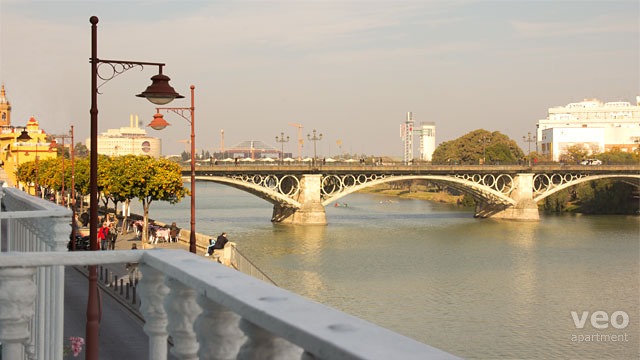 view of the Isabel (Triana) bridge from our Betis Blue apartment
view of the Isabel (Triana) bridge from our Betis Blue apartment
The name is thought to derive from the Roman emperor, Trajano (pronounced Trahano in Spanish), who was born in Italica, the Roman city a little to the west of Seville. While it’s not known exactly how long there has been a settlement here, it’s certainly the oldest of the barrios outside the old city walls, dating back to at least Moorish times. It was in the late Moorish times that the first bridge across the river, the famous bridge of boats, was built (where the Isabella II bridge – usually referred to as Triana bridge – is now), with the original Castillo San Jorge, Saint George’s Castle, at its western end. It was then known as the Gypsy quarter, the Gypsies, or Gitanos, having arrived there sometime in the 15th century. As a poor neighbourhood it supplied many of the sailors who explored the New World, and was intimately connected with the worlds of flamenco and bullfighting, which offered a way out of what was effectively a ghetto.
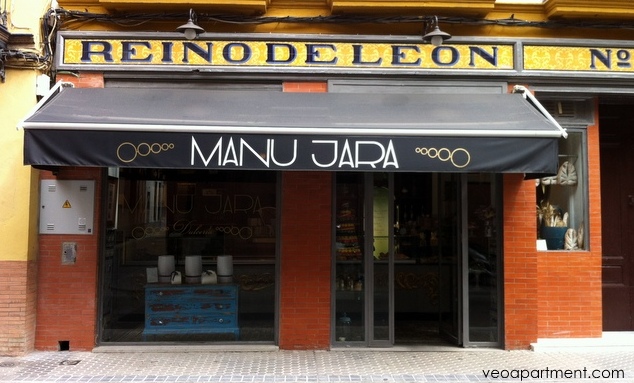 Manu Jara’s “dulcería”
Manu Jara’s “dulcería”
Start your day out with churros and chocolate at the Seville end of the bridge, or some tasty pastries at Manu Jara in Calle Pureza (opens 10am, closed Mondays). Once properly fortified, it’s time to pay a visit to Triana market. Although this was substantially renovated some ten years ago, it still retains much of its traditional charm, with decorative tiled stall fronts (though the names now often don’t correspond to the business of particular stalls), and the colourful displays of fresh fruit, fish and other produce for which Spanish markets are justly famous. I rarely come to Triana without coming here, just for the enjoyment of strolling around until it’s beer o’clock and time for a little refreshment at one of the many market bars.
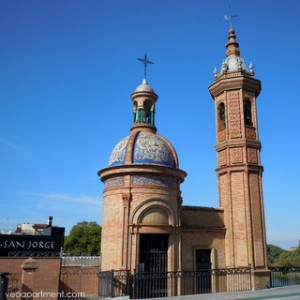 The market is built over the ruins of Saint George’s Castle, once the headquarters of the infamous Spanish Inquisition, and now a museum of tolerance. Emphasis here is on reflection of man’s inhumanity to man, so you won’t see any instruments of torture or other sensationalist displays, but rather an invitation to reflection on the cost of intolerance. Entrance is free, and for me it’s an interesting window on the past. Outside, stop and admire a different aspect of the religious impulse, the chapel of the Virgin of the Carmen designed by Anibál González.
The market is built over the ruins of Saint George’s Castle, once the headquarters of the infamous Spanish Inquisition, and now a museum of tolerance. Emphasis here is on reflection of man’s inhumanity to man, so you won’t see any instruments of torture or other sensationalist displays, but rather an invitation to reflection on the cost of intolerance. Entrance is free, and for me it’s an interesting window on the past. Outside, stop and admire a different aspect of the religious impulse, the chapel of the Virgin of the Carmen designed by Anibál González.
Behind the market is what’s left of the old ceramics district. Although only a shadow of its former self, there are still some craft workshops and you can pick up a nice decorative piece or two as souvenirs. It’s also worth visiting the newly opened ceramics museum (in Calle Antillano Campos, next door to the famous Santa Ana ceramics shop), which I found fascinating, with examples of the old kilns and the equipment that was used, and something of the history of the industry.
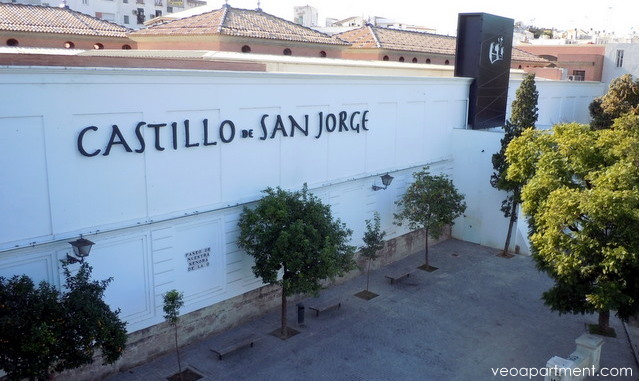 Saint George’s Castle seen from the Isabel bridge
Saint George’s Castle seen from the Isabel bridge
For lunch, walk up the main street of San Jacinto to Las Golondrinas (Pages del Corro, 76), or if you’re feeling adventurous check out Puratasca (Numancia, 5 – almost impossible to find) for innovative tapas in a wonderfully kitsch 70’s ambiance. For something more traditional try Sol y Sombra (Castilla 151) and their famous “solomillo al ajo”, with almost as many slow-cooked garlic cloves as pieces of pork tenderloin.
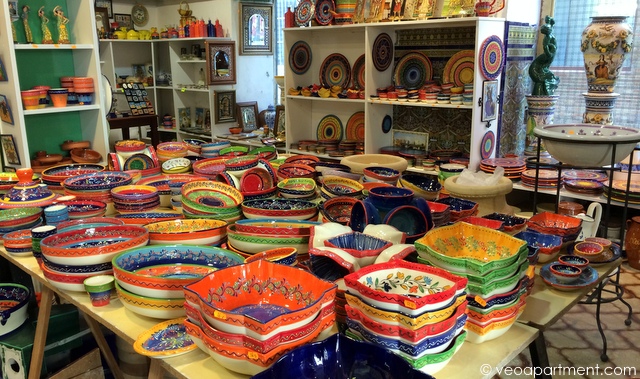 ceramics shop in Triana
ceramics shop in Triana
In the evening the place to be is Calle Betis, the street that runs along the bank of the river opposite the bullring and Torre del Oro. It’s one of the best nightlife spots in Seville, with lots of bars and restaurants with terraces looking across to the old city where you can enjoy a beer or a glass of wine and some traditional seafood as the street gradually comes alive around you. My own favourite place is the Primera del Puente (Betis 66), which serves some of the best fish and seafood around. Tapas at the bar, or raciones on the riverside terrace, the quality is always excellent. Finish the evening at Lo Nuestro, a popular flamenco bar on Calle Betis, or at La Anselma on Pages del Corro.
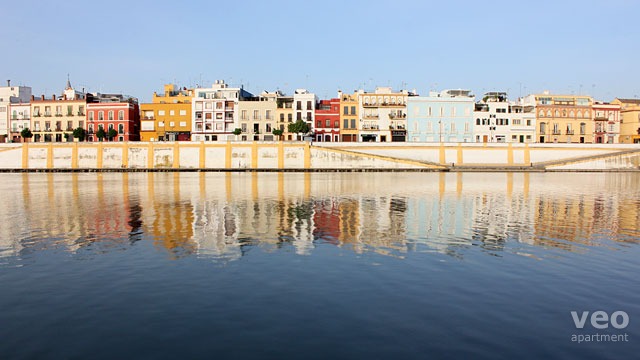 view of Betis street from the “other side” of the river, Seville
view of Betis street from the “other side” of the river, Seville
Of course you could live like a local in one of our excellent holiday apartments in Triana, and take day trips across the bridge to Seville. Take a stroll with us through Triana on our short video.
I stayed in Seville for 6 days and only spent a couple of hours in Triana,next year i`ll definitely spend longer.